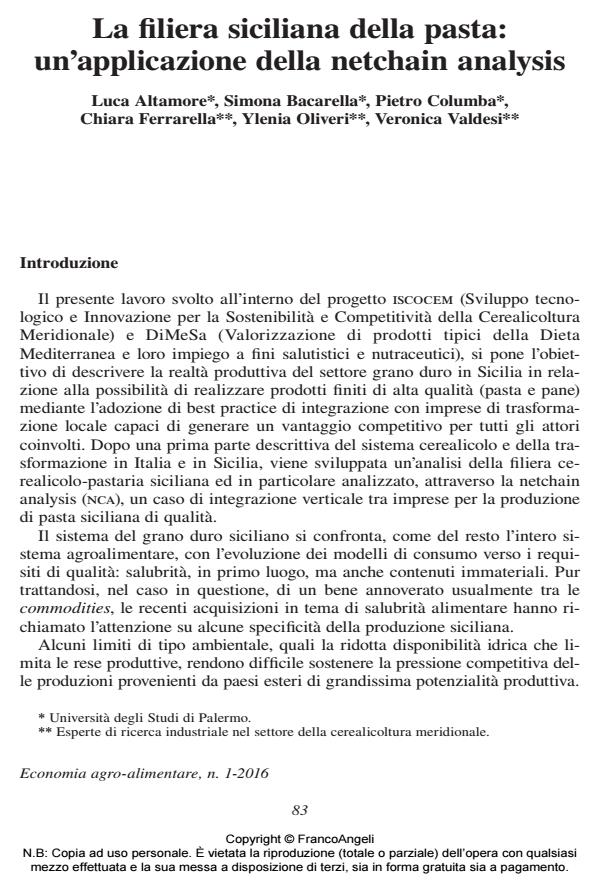The Sicilian pasta supply chain: an application of the netchain analysis
Journal title ECONOMIA AGRO-ALIMENTARE
Author/s Luca Altamore, Simona Bacarella, Pietro Columba, Chiara Ferrarella, Ylenia Oliveri, Veronica Valdesi
Publishing Year 2016 Issue 2016/1
Language Italian Pages 24 P. 83-106 File size 190 KB
DOI 10.3280/ECAG2016-001006
DOI is like a bar code for intellectual property: to have more infomation
click here
Below, you can see the article first page
If you want to buy this article in PDF format, you can do it, following the instructions to buy download credits

FrancoAngeli is member of Publishers International Linking Association, Inc (PILA), a not-for-profit association which run the CrossRef service enabling links to and from online scholarly content.
The system of Sicilian durum wheat is facing, as indeed is happening to the entire food system, the evolution of consumption patterns toward higher quality requirements: health-wise, primarily, but also including some intangible requirements. Recent acquisitions in the field of healthy food, have called attention to some specific characteristics of Sicilian durum wheat. The durum wheat sector represents a major landmark for regional agriculture, being by far the most widespread arable crop in Sicily; a crop that, over the past 30 years, has evolved considerably, due to the impact of EU regulations. Currently, the whole Sicilian cereal-pasta chain shows shortcomings in organization and size, which severely limit the production of pasta with a significant loss of added value, linkable to its specificity characteristics. The study confirmed the substantial absence of a supply chain for Sicilian durum wheat although there have been attempts, even by the regional government, to build a chain agreement aimed at starting a virtuous process of governance of the quality system for cereals. There is a need, however, for commitment in training at all levels of the supply chain, and the promotion of a culture of sharing of common goals as well as collaboration among the operators, is essential.
Keywords: Wheat, wheat-pasta chain, netchain analisys, Sicilian pasta
Jel codes: L14, Q18, Q13
- Italian Consumers’ Preferences for Pasta and Consumption Trends: Tradition or Innovation? Luca Altamore, Marzia Ingrassia, Pietro Columba, Stefania Chironi, Simona Bacarella, in Journal of International Food & Agribusiness Marketing /2020 pp.337
DOI: 10.1080/08974438.2019.1650865 - Green metamorphoses: agriculture, food, ecology M. Ingrassia, P. Columba, S. Bacarella, S. Chironi, L. Altamore, pp.103 (DOI:10.3920/978-90-8686-898-8_6)
Luca Altamore, Simona Bacarella, Pietro Columba, Chiara Ferrarella, Ylenia Oliveri, Veronica Valdesi, La filiera siciliana della pasta: un’applicazione della netchain analysis in "ECONOMIA AGRO-ALIMENTARE" 1/2016, pp 83-106, DOI: 10.3280/ECAG2016-001006